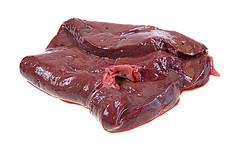



Liver Function and Feed Efficiency in Cattle
Consuming 25 per cent of all energy used by cattle, the liver is hugely important in feed efficiency.This is why policy adviser at the Ontario Cattlemen's Association (OCA) says it is worthwhile to focus on liver in a new project.
Richard Horne, of the OCA explains that, despite the only accounting for 1.2 per cent of body weight, the liver requires a quarter of a cow's energy.
“Although it’s a very small part of the animal’s body, it consumes a quarter of the animal’s energy, and obviously energy plays a huge role in the efficiency of animals,” said Mr Horne.
Dr. Steve Miller and Dr. Yuri Montanholi of the University of Guelph are wrapping up a project that looked at the liver’s role in feed efficiency, write Lisa Geunther of Genome Alberta.
The Ontario Cattlemen’s Association dedicated $100,000 of industry money to the research, which started last September. The federal government kicked in another $264,000 through the Canadian Agriculture Adaptation Program.
Part of the project involved assessing cattle for feed efficiency using traditional performance measures and SNPs, Horne explains. But the project also used advanced liver measures to determine the liver’s role in feed efficiency. Researchers looked at liver histology, oxygen consumption by the liver tissue, mitochondria concentration in the liver tissue, blood analysis, and other lab tests.
“Liver function or advanced liver measures is a variable in determining feed efficiency that hasn’t really been looked at too closely in the past. So this project was fairly unique and targeted in really assessing the liver side of things and determining the efficient animal from the inefficient animal,” says Horne.
Preliminary results indicate that liver function is a trait that can be applied to genetic selection, Mr Horne says.

The Guelph project goes where few have before and assesses the liver of inefficient and efficient animals.
“The downstream goal of this project would be–based on liver measures–how does that contribute to more efficient or less efficient animals in the beef herd? And with that knowledge, how can we select for more efficient animals in terms of the breeding herd?”
This isn’t the Ontario Cattlemen’s Associations’ first genomic research project. Horne says that when it comes to genomic research, it’s difficult to see the results immediately.
Measuring the genetic profile of the beef herd, and improving it, can’t be done overnight, he adds.
“You constantly have to be measuring and evaluating each crop of animals to kind of start weeding it down. So we continue to invest in this type of research. I think the downstream benefits are the greatest.”
Genomics isn’t a one-study issue. It needs continued investment, Horne says. “There are so many animals that haven’t been tested, and the more work that goes into the field of genomics on a broad sense, the better off we’ll be down the line.”
Horne says the role of genomics in the chicken and dairy industries show why the beef industry is investing heavily into genomics research. He says he thinks the industry is getting closer to a breaking point where they’ll see big benefits from their investment into genomics.
The project looking at liver function and feed efficiency wraps up in October.
“I’m sure this study will warrant further studies into feed efficiency based on advanced liver measures in cattle,” says Horne.


